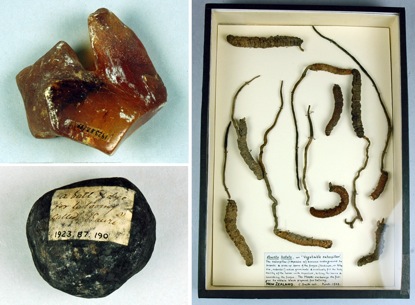Resin, caterpillars and ball of pigment
 Collected by Charles Smith 1860–1908 and purchased from the executors of the Charles Smith Estate via Alfred T. Collier in 1923; 1923.87.190, .198 and .208–.217Māori people, New Zealand, before 1869
Collected by Charles Smith 1860–1908 and purchased from the executors of the Charles Smith Estate via Alfred T. Collier in 1923; 1923.87.190, .198 and .208–.217Māori people, New Zealand, before 1869
Traditional tattoo pigment was made by mixing various types of soot with a carrying agent such as animal or fish oil, or even water. Whilst dark black pigment could be obtained from charcoal, a lighter blue-black or green-black pigment was obtained either from other sorts of soot obtained from resin or caterpillars.
The amber-like resin (fossilized gum) of kauri trees which once forested much of the North Island could be burned on a mat or netting smeared with fat. Another source of pigment was a specific species of 'vegetable caterpillar' (awheto). The caterpillar larvae feed on fungus spores that germinate inside the caterpillar and fill its body cavity with mycelium. The parasitic fungus eventually kills the larvae and feeds off it. The fungus itself is then dried and burnt to create a black pigment used for tattooing.
The tā moko artist (tohunga) is always a man and is often related to the person being tattooed. He keeps the pigment in special carved pots that are often passed down as family heirlooms. He first draws the design on to the skin, then carves it with a sharp chisel tool known as uhi, dipped in the pigment.
